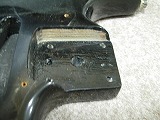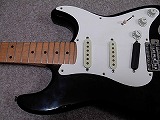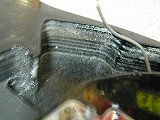
History of Fender JAPAN
Fender Japan was officially created in March 1982 as a joint venture company between
Fender USA, Yamano Music Instrument (Fender USA and Gibson Distributor that time) and
Kanda Shoki (Greco's distributor). Around 1976-1980, Many Japanese Guitar MFGs made
the replica of Fender guitars. Specially, Kanda shokai, they were distributing the
Greco brand Guitar made by Fujigen. Fujigen invested several CNC machine to produce
the accurate wood body shape without time consume. The guitars Fujigen made were
distributing with GRECO Brand as super real series. On the other hand, Tokai and other
MFGs are distributing their guitars with high-technical productivity.
The technology of those guitars were evaluated worldwide better quality
than original
Fender guitars. It seems that Fender USA established the Fender Japan as one of solution/
decision to protect their brand name and market.
The Fender Japan guitar manufacturing contract was originally going to go to Tokai in
1981/1982 but at the last minute Fender choose Fujigen Gakki instead.
Fujigen is located in Nagano city. Therefore, Fujigen used many sub-constructor
for this project
Some Fujigen made Fender replica between 1982 and 1997 have necks made by Atlansia.
Tokai and Dyna Gakki took over the production of the Fender Japan models
from Fujigen
in 1996/1997. The Tokai made Fender Japan guitars are not exported from Japan but some
of the Dyna Gakki made Fender Japan guitars are exported.
Dyna Gakki have made various guitars for Kanda Shokai's Greco brand.
Terada made the Fender Japan acoustic guitars such as the Fender Catalina.
High End products had a US made hardware (Fractional sie screws and etc...)
But standard range guitars used the Gotoh Pickups as standard
"Made in Japan" and "Crafted in Japan" and its rumors
According to a Fender representative, it was in the Fender Japan contract that
if there was a change of manufacturer from Fujigen Gakki to another guitar factory then
the logo would be changed from MIJ ("Made in Japan") to CIJ ("Crafted in Japan").
The first CIJ Fenders start around 1992 but most of the Japanese Fenders up till
1996/1997 are MIJ Fenders. In 1991/1992 Fujigen were expanding their factory
operations
by establishing Fujigen Hirooka Inc. to be able to take on additional set
neck
(Gibson like necks) contracts (such as the Orville by Gibson contract).
At the result of production delay during this Fujigen new facility expansion,
Dyna Gakki took over some of the production of the Japanese Fender models which
resulted in a CIJ logo being used on some Japanese Fenders instead of a MIJ logo.
CIJ is mostly used on Fenders from 1996/1997 until recently due to Tokai and Dyna Gakki
taking over the Fender Japan manufacturing contract from Fujigen Gakki
in 1996/1997.
The Fender Squire were also brought into line to be in sync with the Japanese
Fenders
at around the same time (1996/1997) with 'Crafted' rather than 'Made' being used.
"Made in Japan" is used on some current Fender Japan models (2007) instead of
"Crafted in Japan".
1982: Fender Japan starts production with Fujigen Gakki having the manufacturing contract.
The "Made in Japan" (MIJ) logo is used.
1984: CBS sells Fender to its current owners and while waiting for a new USA factory
to begin production, Fender Japan models and leftover USA stock were mostly sold
in the USA for a few years.
1992: The first "Crafted in Japan" (CIJ) models start appearing due to Dyna Gakki taking
over some of the manufacturing while Fujigen were expanding their operations.
1996/1997: "Crafted in Japan" (CIJ) is used instead of "Made in Japan" (MIJ).
Tokai and Dyna Gakki took over the manufacturing contract from Fujigen
Gakki.
Why Fender Japan stopped the deal with Fujigen? I have heard that Kanda
and Fujigen
got a serious quality issues. Since Fender Japan started, Fujigen has been
supplying most of
Fender Japan products. Dyna was a sub-constructor of Fujigen too.
Fujigen didn't listen the requests from Fender Japan. Then, finally, they
decided to cancel
the contract. As you may know, Fender Japan = Kanda Shokai management.
They have ended the business relations since they have Greco golden time.
There are still many rumors that "Crafted in Japan" marked are not assembled in Japan.
The Japanese users said, all wooden works are done out side of Japan, Tokai or Dyna
just assemble them ! I think it just rumors. To think about the production
process,
if Fender Japan done so, they had better assemble all in China or Indonesia.
They should think about the cost effectiveness.
The freight between Japan and China/Indonesia could not allow them to do.
I think they are still asking the Japanese Guitar Manufacturers.
However, the parts should be came from outside of Japan. Like Tuner(Korean made, Japanese
MFG license products !), other hard ware and Pick-Up (Mexican made, possibly !)
I have seen many Fender Japan, the wood materials, to compare with vintage and current
at same pricing level, vintage Fender Japan are absolutely better.
The end-user said JV serial, Fender Japan and Squire are great.
The pricing of these JV serial has been vry high. Well, these are early
stage of
Fender Japan made by Fujigen. It is exactly same with Greco Stratocaster.
I have heard that at the beginning, Fujigen took off Greco logo and put Fender logo.
They just change the hardware's which Fender Japan provided.
I'm not sure this is rumor again !
Caution : Fender Japan MIJ and CIJ Fake Guitars
We have been handling many Fender Japan products. However, recently we
could find out
many Fake FJ Guitars. Specially, the early date serial numbers products, we saw many cases.
1) Only neck is original, but the body is cheap ply wood (This should be
Korean made Squire
body. This body was used early time of Korean made Fender). They just bought
the neck and
assemble it. It is very tough to find the fake or not. Take off the neck
and check
the neck pocket or PU cavity. It is only way to find out.
2) Many case, the fake guitar has non-original PU. It is O.K., If they
have indicated it.
But in many cases, they didn't indicate and use the Cheap PUs like Korean or China Made.
We strongly recommend you to ask the exhibitors about it.
In case of our company, we would not sell the Fake. We just take off only the original
parts and sometimes use these original parts only for repairing or rebuilding.
We definitely indicate that "this is not original" or "Rebuild"
on the explanations.
The technique of making the fake is getting well (I must say).
Hope, the seller would understand the products well, to be honest for the business.
the buyer should be very carefully.







